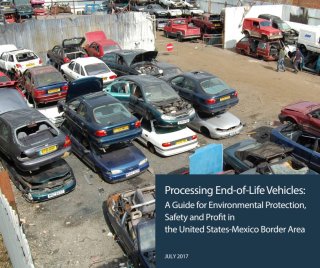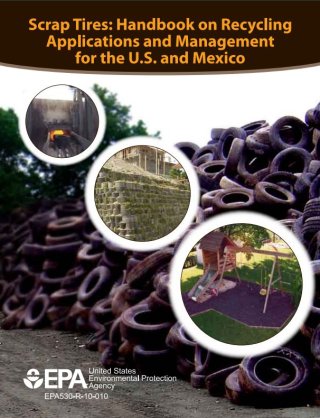Land Policy Workgroup
Goal 3: Promote Materials Management, Waste Management, and Clean Sites
The border region faces significant challenges that threaten its ability to achieve clean, sustainable communities. Improperly managed waste results in air, water and land pollution, including contributing to marine litter. Increased trade, manufacturing and population growth in the border region has led to increased waste; yet, the current waste management structure is not adequate to meet border communities’ increasing needs. Solid wastes can include materials generated by business (commercial and industrial waste), building materials (construction and demolition debris) and residents (municipal solid waste). Improperly managed waste results in air, water and land pollution. To ensure the future health and safety of the communities within the border region, we need to move away from a linear approach of make, use and dispose, to a circular, life-cycle approach, reducing waste and optimizing resource use.
Mismanaged waste and litter from coastal and inland locations make up the majority of marine litter that pollutes our oceans. Marine litter, including plastic waste damages ecosystems, threatens economies, especially those related to the tourism and fishing industries. The issue requires solutions that involve varied approaches that address land-based sources of marine litter through improved solid waste management practices and litter capture.
Promoting sustainable materials management and resource efficiency practices throughout the border region provides opportunities for partnerships, innovation and job creation. It is necessary to collaborate at all levels of government, communicate with community stakeholders and collaborate with the private sector to apply limited resources to reduce pollution and prevent adding to legacy contamination in the region.
Over the next five years, the U.S. and Mexico will work collaboratively to address the following challenges in the border region:
- Shortage of materials management collaboration opportunities that address common marine litter materials.
- Lack of adequate planning programs that establish strategies to minimize waste, promote safe materials reuse, develop efficient collection systems, support secondary materials markets and composting infrastructure, reduce overall disposal in open dumps, and improve disposal site operations.
- Absence of adequate waste characterization and measurement of generation, disposal, illegal dumping, recycling and composting data to support the development and tracking of waste reduction programs.
- Limited knowledge and experience in identifying financing mechanisms and resources to establish and implement a holistic solid waste management system.
- Inadequate infrastructure and services to manage trash and other solid waste, including plastics, which when left unmanaged can reach shared waters contributing to marine litter.
- Environmental, social and economic impacts of indiscriminate dumping and contaminated sites resulting in high remedial costs and addressing the limited implementation and enforcement of current laws.
Note: To see the full details of each goal refer to the framework.
Objective 1: By 2025, share information and experiences on sustainable materials management and resource efficiency practices with local and state-level institutions, tribal governments, and indigenous and Afro-Mexican communities.
Objective 2: Identify priority waste streams and develop sustainable materials management and resource efficiency practices that strengthen their respective market value.
Objective 3: By 2025, improve knowledge at every level of government (federal, state, local) to improve solid waste disposal site operations.
Objective 4: Prevent and Reduce Pollution in the Marine Environment.
Objective 5: On an annual basis, implement the Binational Consultative Mechanism on sharing information on border area hazardous waste facilities, spent lead acid battery and electronics recycling facilities.
Webinars
Circular Strategies for the Sustainable Management of Scrap Tires – Part 1: Connecting Border-wide Work and Initiatives on Scrap Tires

Scrap tires pose an enduring risk to public health and the environment on both sides of the US-Mexico border, and remain a high priority for interested parties throughout the region. The Border 2025 Goal 3 workgroup is planning a two part webinar series on scrap tire management. This Part 1 session will help to connect ongoing border-wide work on scrap tire management by outlining state policies and initiatives, highlighting available resources, and providing a space for discussion to identify gaps, priority issues and opportunities for future work.
Presentations for Part 1 Webinar on Scrap Tires (pdf)
RESOURCES FOR YOUR COMMUNITY
Environmentally Sound Management of Waste: International Initiatives

This guide provides vehicle dismantling and scrapping facilities and their operators with information on proper removal, storage and handling of potentially hazardous materials from discarded vehicles. Removing hazardous materials will help ensure that vehicles can be safely stored and processed, maximizing the recovery of valuable resources and mitigating worker safety, public health and environmental risks. By training staff to properly handle and prepare vehicles for scrapping and recycling, facilities can remove more of these vehicles from border communities and provide environmental, economic and aesthetic benefits. This guide provides general guidance and best practices for your assistance - it does not replace local laws and regulations.
The guide is also available in Spanish.
Solid Waste Management Guide for Developing Countries

The Best Practices for Solid Waste Management: A Guide for Decision-Makers in Developing Countries (guide) is focused on best practices for solid waste management in medium and large urban centers in developing countries. To complement the guide, EPA developed a series of online interactive learning modules to complement the guide. The modules allow users to explore specific topics related to waste management in a user-friendly platform.
This guide is also available in Spanish.
Scrap Tires: Handbook on Recycling Applications

This Handbook provides technical, environmental, economic and reference information for government and private industry. This resource can further efforts to clean up stockpiled scrap tires and prevent additional piles, assisting in the cleanup of border communities.
The Handbook is also available in Spanish.
